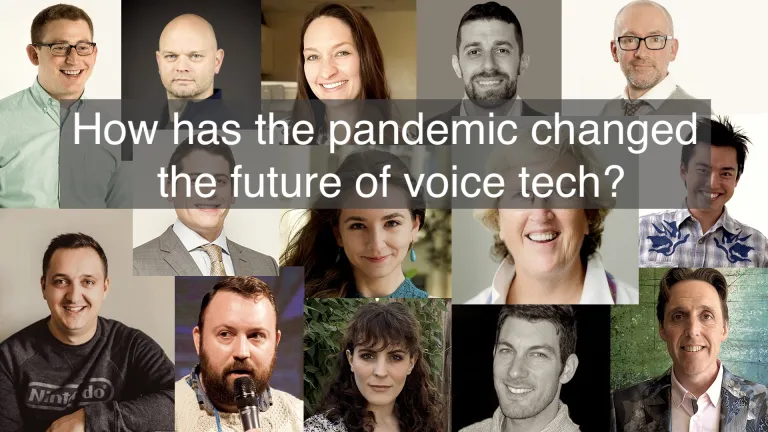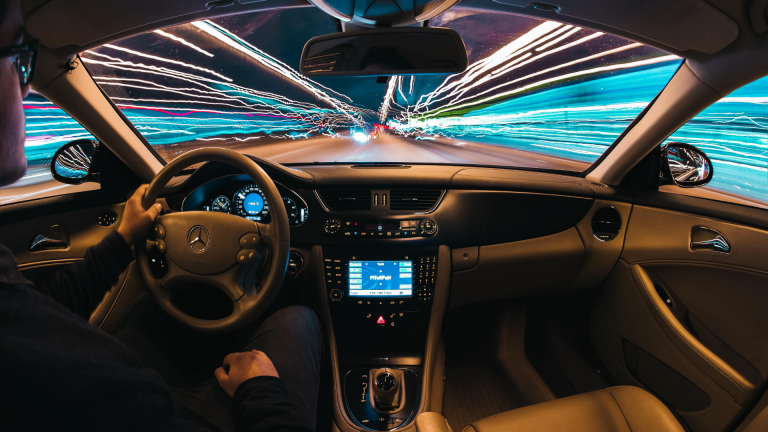If only we could make predictions with the clarity of hindsight. Last year, experts predicted that the adoption of voice AI would move quickly into the IoT space, and that we’d overcome many barriers to adopting voice, including the need to show immediate ROI. This year we did see voice making an entrance into the IoT, but not at the rate anticipated. Additionally, there are still hurdles when it comes to proving immediate ROI, although brands are beginning to overcome these challenges by reframing the conversation around what it means to monetize with voice and focusing on the long tail.
As we move forward, we’ll use hindsight to inform our predictions, recognizing that every step forward leads us closer to a voice-first world where people can talk to devices that understand them and respond accurately the first time.
We’ve gathered predictions on the future of voice AI from a panel of experts and thought leaders to kick off 2020 planning:
1. Phone-zombies will be a thing of the past
“We’ll see more devices that try to avoid the cloud for both privacy and performance reasons. Voice AI on the edge for low-resourced IoT devices will come to the fore. Hearables and wearables will be the catalyst for greater usage of voice over a wider variety of use cases, as these are inherently hands-free. Phone-zombies may even begin to disappear!”
– Carl Robinson, host of the Voice Tech Podcast.
2. Accessibility will improve, for everyone
“2020 success stories will come from heightened niche awareness and voice experiences driven by accessibility and domain context.”
– Heidi Culbertson, CEO, Marvee.
“2020 will see more brands build custom voice agents in their own image, particularly relevant when the brand controls the consumer touch point, such as the car, the drive through, or even call centers or mobile apps. Brands will continue to struggle with discoverability on mainstream voice assistants and grapple with big tech voice platform limitations and trade-offs—data access and sharing, clunky invocations, voice synthesis inflexibility, competition with first-party capabilities, and more. This will point many brands toward increased interest in leveraging white-labelled voice AI solutions that can be delivered to customers through channels that brands own and manage. Because of their scale and advanced capabilities, mainstream voice assistants will still see sizable investment from big brands, but this will be tempered with a desire for greater control of the branded voice experience outside of Alexa and Google Assistant-enabled devices and environments,”
– Eric Turkington VP, Strategic Partnerships RAIN
4. Personalization will enhance experiences
“Voice-controlled AI will be more personalised in several different ways: it will become more mobile and more wearable, with sensors, GPS and microphones in items like spectacles and clothes, capturing data to detect our location. It will better anticipate our individual needs and it will understand our future needs from previous requests and link several suggestions into a seamless personalised experience, such as booking a cab, buying tickets and making reservations for a night out.”
– Peter Stewart, author, consultant, speaker, The Smart Speakers Podcast.
5. Audio strategy becomes mission critical
“I think in 2020 brands will start to realize having an audio strategy to reach their audience will no longer be a “nice to have,” but a “must have.” Audio also includes things like voice, podcasts, sonic branding, etc. — anything that will create an auditory or conversational experience. This will be different from a social media experience, because it will focus more on a one-to-one interaction. So the question brands need to ask themselves is, “How would I talk to and interact with one person from my audience in a way that is helpful, supportive or entertaining?” Think more human. How do you show you care?”
– Keri Roberts, brand and content strategist, host of the Inside VOICE Podcast.
“2020 will see ongoing momentum for independent voice AI platforms given the opportunity to extend a company’s product experience and maintain control over their brand and data. The continuing evolution of advanced voice technology will further entice a broad range of automotive and non-automotive companies to adopt their own voice assistant. By the end of the year, every IoT-related industry will include companies who have announced plans to release their own custom voice assistant using an independent platform.”
– Mike Zagorsek, VP of product marketing, SoundHound Inc.
7. Natural language processing takes center stage
“2020 will be the year we roll up our sleeves and get stuff done. I think we’ll see more companies realise that natural language processing is the key driver here, and find ways of working with conversational AI in both text and voice modalities as part of a broader assistant strategy. It will be a safe year to launch your first voice experience. Lots of risk-taking has already been kicked off in some industries, so a path is starting to become clear.”
– Kane Simms, Co-Founder, VUX World.
“It’s all a bit chicken and egg: people are trying shopping with voice, so retailers are taking notice, and building those functionalities. But users can’t try out retail experiences which don’t exist. As a result, 2019 has seen voice shopping limited to specific industries and retailers, whereas 2020 will widen the playing field as users and developers explore together,”
– James Poulter, CEO and Founder, Vixen Labs
“2020 will be largely about the platform space race. Amazon has continued to maintain market share through distribution, strong partner programs, and marketing, but I see Google, Samsung, Houndify, and other platforms making very strategic moves that will heat up the competitive nature of the channel in 2020. Our agency adage is that Voice is not a PROJECT, Voice is a PROGRAM, meaning we need to be thinking about all of the pieces of a full campaign puzzle, rather than simply an isolated voice app. How does your voice app tie to your other marketing channels, what’s the real goal of your program, what data are you collecting, what iterative approach are you taking, etc, etc. Success in voice will require a full strategy.”
– Brandon Kaplan, founder and CEO, Skilled Creative.
10. Voice-first interfaces will grow
“For 2020, I expect to see more people using conversational and voice interfaces to supplant search as the easiest way to navigate apps and find information. Furthermore, discovery of voice applications through personalized implicit/name-free invocation finally becomes delightful, and starts to drive a significant amount of application usage on all of the voice platforms.”
– Dennis Yang, co-founder and CPO, Dashbot.
11. Monetization will cease to be a barrier
Voicebot.ai added this prediction by the CEO of Dashbot in a recent post and we wanted to include it since the content is so timely and addresses one of the three greatest challenges experienced by brands we’ve talked to.
“As with any new channel, user acquisition/discovery and monetization can be challenges. For voice assistants to continue to take off, and more users and enterprises to adopt them, I am hopeful the ecosystem continues to evolve and more opportunities for user acquisition/discovery and monetization come forward. As the ecosystem evolves, and enterprises see the value in voice assistants, hopefully more initiatives move from innovation teams to business units in the coming year. We are still relatively early in this space, and it is exciting to see new use cases that emerge.”
– Arte Merritt, co-founder and CEO, Dashbot
12. Design will lead the voice industry
“Even with massive adoption by consumers and intense investment in and acquisitions of voice technologies by businesses, the industry is still grappling with a lack of monetization opportunities. The key to uncovering the value of voice lies in design––more emphasis on the conversational design process and designers working in the voice space. We’ll see an increasing number of UX designers, writers, and product people fostering the skills needed to create voice applications and assume more prominent roles in building voice technology. Teams primarily comprised of developers will hire designers to transform how they approach voice interfaces and improve user experience as a result. Better tools and resources will be created to meet the needs of voice designers. This shift will create an influx of design-driven voice experiences that will provide more value for consumers and businesses alike.”
– Lauren Golembiewski, co-founder and CEO, Voxable
13. More brands will optimize for voice search
“In the new year, brands will realize the importance of voice search optimization and specifically design names of products to be best understood by speech recognition and natural language processing. Not only will marketing and branding experts be consulted, specialists in language content such as linguists and phoneticians will be hired from graduate programs and other consultancies. Visual puns and playing on words that worked visually will often not translate to the spoken word. A prime example is “Parton me” as a promotional code for the podcast, Dolly Parton’s America. While the joke is clever, it may seem less clever when the natural language processing and search query can’t find the right matches.”
– Dr. Joan Palmiter Bajorek, head of conversational research and strategy, Versa.
“I think that media-based companies will drive some of the most interesting innovation in the voice space by supplying content in new formats that are conducive to voice assistants and their affiliated hardware. NPR, the BBC, Discovery, Disney and other media companies will shed a light on how content can become more dynamic and voice-enabled as they continue pushing the envelope around what’s possible with new modalities such as smart displays (for example, Food Network Kitchen). I also think we’ll see hearables like AirPods continue to play a prominent role within the voice ecosystem, particularly as on-the-go applications are developed and take advantage of mobile data inputs, such as GPS.”
– Dave Kemp, creator & publisher, FuturEar.
A few more thoughts and predictions
Some of our influencers had a lot to say about voice in 2020. So we thought we’d add in a few additional predictions here:
“We can look forward to using any smart speaker in the world with reduced friction and more relevant responses, thanks to advances in biometric authentication and emotion recognition.” – Carl Robinson.
“Voice-controlled AI will become better at understanding what we are saying, how we are saying it and the context in which it is being said, and be better at replicating that emotion and ‘empathy’, not only addressing us in our preferred way but also in the tone, pitch, speed and voice that better suits our personalities, mood or location; and it will reassuringly have increased recognition of each user’s voice’s tone and timbre for added security.” – Peter Stewart.
“Beyond the current established platforms (Alexa, Google et al), I’m enthused to see voice breaking out of the smart speaker and becoming the go-to interface on websites, mobile apps and other customer touch points. I don’t think 2020 will be the year for widespread adoption and usage necessarily, but I do think companies will begin to turn their attention towards adding voice to their own assets and touch points, rather than relying on the big players.” – Kane Simms.
“People speaking into devices are changing their speech to get better accuracy. People slow down, add more pauses, and articulate parts of words that during a normal stream of speech they would not say so clearly. This may also begin to affect how humans speak to one another and how coarticulation (how words smoosh together when we speak naturally) works in spoken language. Language is constantly evolving, and if voice technology is taking off it will change our human behavior while speaking to the device and elsewhere.” – Joan Palmiter Bajorek
“Media companies like Meredith Corporation, Wall Street Journal and HBO have been launching some of the most robust voice experiences, and media solves two of voice’s largest challenges: discovery and lack of content. For media organizations to be able to really help grow the channel they will need to be able to generate advertising or subscription sales. This will require attention to ad policy, and quality commerce features.” – Brandon Kaplan
The predictions are in and the year of voice tech has already kicked off with two exciting events, CES 2020 and Project Voice. We’re anticipating growth in the market and more adoption of voice user interfaces in more industries.. Thank you to all the experts who shared their predictions on the possibilities of voice AI in 2020. We’ll check back next year to see how our predictions played out, assess our progress, and try again.
If you’re a brand looking to build custom-branded voice solutions for your customers, learn more about Houndify, our independent voice AI platform.
Karen Scates is a storyteller with a passion for helping others through content. Argentine tango, good books and great wine round out Karen’s interests.









